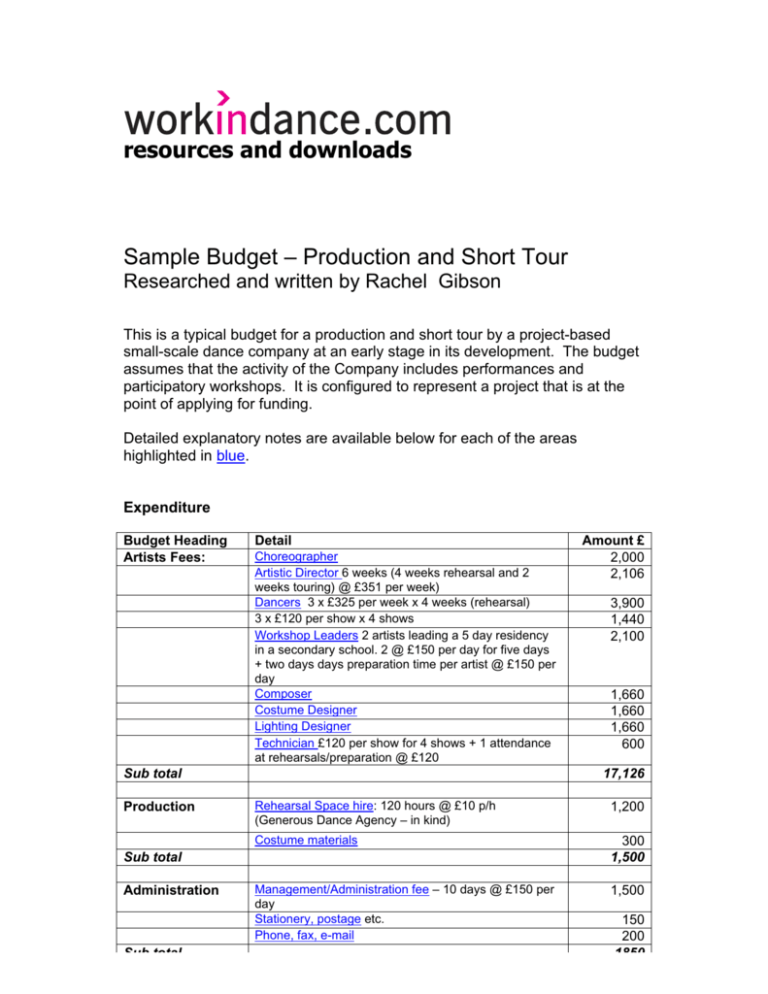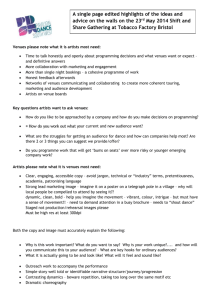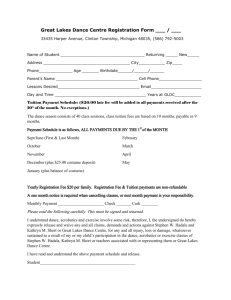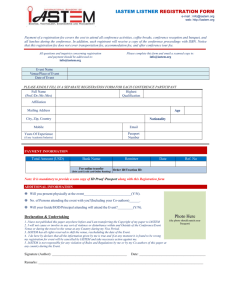resources and downloads Sample Budget – Production and Short
advertisement

resources and downloads Sample Budget – Production and Short Tour Researched and written by Rachel Gibson This is a typical budget for a production and short tour by a project-based small-scale dance company at an early stage in its development. The budget assumes that the activity of the Company includes performances and participatory workshops. It is configured to represent a project that is at the point of applying for funding. Detailed explanatory notes are available below for each of the areas highlighted in blue. Expenditure Budget Heading Artists Fees: Detail Choreographer Artistic Director 6 weeks (4 weeks rehearsal and 2 weeks touring) @ £351 per week) Dancers 3 x £325 per week x 4 weeks (rehearsal) 3 x £120 per show x 4 shows Workshop Leaders 2 artists leading a 5 day residency in a secondary school. 2 @ £150 per day for five days + two days days preparation time per artist @ £150 per day Composer Costume Designer Lighting Designer Technician £120 per show for 4 shows + 1 attendance at rehearsals/preparation @ £120 Sub total Production Sub total 3,900 1,440 2,100 1,660 1,660 1,660 600 17,126 Rehearsal Space hire: 120 hours @ £10 p/h (Generous Dance Agency – in kind) 1,200 Costume materials 300 1,500 Management/Administration fee – 10 days @ £150 per day Stationery, postage etc. Phone, fax, e-mail 1,500 Sub total Administration Amount £ 2,000 2,106 150 200 1850 Marketing Print design Print production ( 200 A3 posters, 2000 A5 leaflets) Photography (fee and materials) Sub total Travel Artists travel to 4 venues in London and SE (av. £15 per venue) + travel for residency (5 days@ £4.50 per day x 2 artists) Sub total Contingency (5%) Total Expenditure 500 800 500 1,800 285 285 1,130 23,691 Income Budget Heading Earned Income Detail 1 venue – fee £800 3 venues – box office split – av. attendance 150 – 33% @ £10/67% @ £12 – 60/40 split – less VAT School contribution to residency £ 800 4,211 370 Sub total In kind support Sub total Rehearsal Space hire - Generous dance agency Subsidy Arts Council England (this application) Esmee Fairbairn foundation (awaiting decision) Other trusts and foundations (for residency) Total Income 1,200 12,000 3,000 2,110 23,691 Notes to Budget 1. Design and print costs – based on quotation from our usual design company – Q Designs 2. In kind support confirmed 3. Applications to Trusts and Foundations. Have submitted an application to Esmee Fairbairn Arts and Heritage programme and am currently researching local trusts and foundations which may have with an interest in the geographical area in which we are working for support towards the school residency. Budget Annotations These notes are intended as a guide to establishing rates of pay and other points to consider when constructing a project budget. The rates of pay given here aim to reflect current ITC/Equity minimum rates, but as these are devised primarily for theatre companies, there are areas where precise equivalencies are not possible to establish. The reality for many small scale dance companies is that ITC/Equity minimum rates are a baseline, but a good deal of negotiation between individuals is used to arrive at a budget that is workable within the resources available. See http://www.equity.org.uk and http://www.itc-arts.org Choreographer Fee The role played by a choreographer in many small-scale dance companies is a multi-faceted one. The fee indicated here represents the amount paid solely for the creation of the work. But the choreographer may also be the Artistic Director of the company in question and may also be dancing in the piece. This budget assumes that the choreographer is also the Artistic Director of the Company but is not dancing in the piece. Research into payscales in dance undertaken during 2003 revealed that small scale dance companies were paying choreographic fees of between £2,000 and £5,000, depending on the length of work to be created. E.g. if more than one work was to be commissioned as part of a double or triple bill then the amount paid to each choreographer might be towards the lower end of this range. For a full-length work it might be towards the upper end. There is no published ITC/Equity minimum for choreographic fees. The only partially relevant equivalencies are in the ITC/Equity recommended rates for directors and writers (given that a choreographer generally fulfills a combination of the two roles). In 2002/03 these were: • • • • • Director’s fee (full length play) Director’s fee (short length play) Writer’s fee for over 70 minutes Writer’s fee for under 70 minutes Writer’s fee for under 30 minutes £912 £625 £5,600 £3,732 £1,866 Artistic Director Fee The ITC/Equity minimum for Artistic Directors for theatre productions is £351 per week. Dancer Fees The current ITC/Equity minimum rate for performers is £302 per week. Research into payscales in the dance sector undertaken in 2003 revealed that small-scale dance companies were typically paying dancers between £300 and £350 per week. For many small scales dance companies the fairest and most cost effective way of paying dancers is to offer a weekly fee, based on but often slightly higher than the ITC/Equity minimum and negotiate a “per performance” fee for each performance, particularly where only a small number of performances are planned and/or where performances do not fall conveniently into a specified period of weeks. This budget is based on a weekly fee for four weeks rehearsal and a “per show” payment for four performances. There is no recommended minimum rate for “per show” payments, but the figures given here reflect current practice in the sector. Workshop leaders Where a Company is undertaking education or other participatory work as part of a project fees the budget should include provision to pay for this area of work. Where appropriate skills exist within the Company it is common practice for company members to lead participatory activity. If the performing company does not include experienced workshop leaders and the company still wishes to carry out participatory work then it would be necessary to contract to freelance community dance artists for this area of work. The fees shown in this budget reflect Arts Council England’s current recommendations for pay to artists working in educational or community settings. These are: • • £150 per day for contracts of less than two weeks For a residency of two or more consecutive weeks of five days each, a rate based on a pro rata annual salary of £20,000. Whilst these are the recommendations in play for work that is subsidised by Arts Council England, freelance community dance artists work in a wide variety of contexts and their rates of pay may be informed by comparators in related sectors such as health or further/higher education. The Payscales Research carried out for Dance UK and the Foundation for Community Dance during 2003 found daily rates within the community dance sector ranged between £80 and £400 and weekly rates between £350 and £800. Composer fee There is no published standard rate for composers writing original scores for dance. Where dance companies employ a composer, they usually arrive at a mutually acceptable fee by negotiation Costume Designer The recommended ITC/Equity minimum rate for designers in 2002/03 is £1,651.50 Lighting Designer The recommended ITC/Equity minimum rate for designers is £1,651.50 Technician Most dance companies operating at this scale would not be able to afford to pay a technician on anything other than a sessional rate. The rate shown here gives the technician parity with the dancers on a show by show basis. Rehearsal space hire Rehearsal space is obviously a key cost in any dance production and many companies will have no alternative but to pay for rehearsal space. This budget, however, shows the company receiving a donation of rehearsal space in order to demonstrate the importance of what are known as “in kind” donations to a project. For companies at an early stage of development and with limited resources, donations of materials or items such as space can make the difference between being able to do a project or not. Although no cash transaction is involved in these arrangements, it is advisable to include a line in the budget to represent the value of the donation because: • • • It demonstrates the real costs of the project It shows that the company has support from another organisation, which implies there is enthusiasm for the company’s work from that organisation Most funders will not fund 100% of the cost of any project and will expect applicants to show that they are in receipt of support from other sources and in kind support “counts” in the view of most funders as a source of partnership support. When costing in kind contributions you should: • • Work out what the item in question would have cost you had you had to pay for it Show this amount as expenditure and a balancing amount as income from the donor on the income side of the budget. Always make sure that in kind donations appear on both sides of the budget. It is particularly problematic if you include an in kind donation on the income side and omit the equivalent amount from the expenditure side as the resulting budget will be short of the cash resources required to fund the remaining aspects of expenditure. Management/Administration Fee The way in which small scale dance companies handle project administration varies enormously. In some instances the Artistic Director or another member of the performing company will handle the administration, in others the services of a freelance administrator will be bought in. Many freelance administrators work with a portfolio of dance artists and companies. This budget makes provision for 10 days of administrative work. The daily rates charged by freelance administrators vary enormously, depending upon their specialisms and experience. Many operate a sliding scale of charges which are responsive to a client’s ability to pay – charging more to established organisations and less to those who are dependent small project grants. If you are to make best use of any resources that you have available for administration it is worth thinking carefully about exactly which aspects of management or administration are important for the particular project you are planning. For instance, if you feel you need someone to take charge of the day to day running of the project, carrying out basic admin tasks you would probably do best to contract someone at an average daily rate for a relatively high number of days. If, on the other hand, you are at a stage where you feel you could confidently handle aspects of the day to day management and what you really need help with is tour booking and extending your relationships with venues, then it might make more sense to contract a dance manager with sound experience of touring at a higher rate for fewer days to take forward this aspect of your development. Costume Design, Stationery, Postage, Phone, Fax, E-mail These areas of the budget are based on typical amounts that a small-scale company might spend on these items. There is no formula for estimating these costs. The best way of establishing sensible figures is to talk to colleagues and, as your own work develops, use your growing knowledge to assess what these areas are likely to cost. Print costs If you have not commissioned publicity material before then talk to friends and colleagues to find out who has designed and printed material for them. You will probably have strong ideas about the kind of visual image that you would like your work to project. You may be adept with ICT design packages and able to work up your own publicity material designs, or you may need to employ a designer to do this for you. When approaching designers and/or printers always get quotes, preferably from at least two or three companies. Find out what the difference in price is between one colour, two colour and full colour printing and how much it would cost to print extra leaflets and/or posters. Before deciding on sizes and quantities, consult with venues to find out what size and number of posters/leaflets they expect. Find out too whether the venues will overprint (i.e. put the details of the specific performance onto the poster) or whether they expect you do have done this. If your posters and leaflets will need to be overprinted then ensure that you leave space within the design to take the overprinted information. If you undertake this basic research you can be confident that your budget figure reflects the actual amount that it will cost you to produce appropriate size and quantities of publicity material. Photography Dance tends to be a photogenic art form and good quality pictures are an extremely valuable marketing tool. Not only can they form the basis of your publicity material, but you will need them for inclusion in any seasonal brochures that venues produce and as a tool for encouraging preview and review coverage in listings magazines and the press generally. It may be that you or another member of the Company is a competent enough photographer to generate good quality pictures, in which case you would only need to include the cost of materials in your budget. This budget assumes that a freelance photographer will be contracted to take photographs and includes provision for a fee as well as materials. Whether you take your own pictures or employ someone else to do it, there are advantages in terms of convenience and cost if you create digital photographs. Printing costs are reduced and there is less wastage of unsuitable images. Pictures also can be e-mailed directly to designers, promoters, press contacts, etc. thus speeding up the delivery of material and avoiding loss or damage of images in transit. Travel and accommodation The cost of travel and accommodation will vary from project to project. The example given here assumes a very modest tour to only four relatively local venues and no requirement to tour sets or other items that would have to be transported in a van. You will need to do some research to find the cheapest way of getting your company comfortably and reliably to rehearsals and to venues on tour. If you have set and costumes to transport then you will need to ensure that you have the resources to move these from venue to venue as well. If you are taking performers to venues at a distance from their homebase then you will also need to budget for overnight accommodation. If you are using ITC/Equity contracts then there are stipulations regarding kinds of provision that you need to make for travel and overnight stops and you will need to take account of these in your budgeting. A fairly typical formula for a small tour would be: • • • A car or van (depending on how much equipment you have) for costumes, set and props. You will need to ensure that there is someone available to drive the vehicle and that doing so does not place an undue burden on one individual. It is not good practice to expect a technical manager to drive a long distance to a venue, do the get-in, run the show, do the getout and then drive back again late at night. If you are using a car then it may be possible for some performers to travel with the equipment and share the driving Public transport for performers if you cannot accommodate them in a tour vehicle. Remember that many train operators offer cheap tickets if you are able to book far enough in advance. Remember also that if you are using public transport for some or all of your company that it may not run late enough for them to return to home base after a show in which case you will need to pay for overnight accommodation Contingency A contingency is an unallocated sum in the budget to meet unforeseen costs. It is advisable to have a contingency as there are bound to be things that you have not been able to take into account in your plans and it provides you with some flexibility. It is usually calculated as a percentage (5% or 10%) of the overall budget. If you are preparing a budget as part of a funding application it is advisable to check with prospective funders whether they have any expectations about the level of contingency that you should be including. Some do expect to see a contingency at a certain level, others do not have a strong view on the subject. Expenditure and income totals It is essential that these balance. Obviously you do not want a project to be loss-making as the liability for meeting any losses will fall to your company, or if you are working without a formal company structure to you personally. If you are applying to a statutory or charitable body for funding they will not support a project if it is profit-making in any way. So it is important that your budget is a break-even one – i.e. one that shows neither a loss or a profit. In order to achieve a balanced break-even budget you will probably have to rework your figures a number of times, taking into account the likely realistic sources of income and tweaking the expenditure figures so that the total matches the likely income sources. Earned income Earned income is any money that you will earn as a result of showing work you have made, conducting workshops or education work etc. It is generated through the “selling” of your product (performance, workshop etc.) to a venue, school or other host. When you construct your budget you will need to make a realistic estimate of how much income you are likely to earn. To do this you will need at the very least to have had initial conversations with venues to establish levels of interest. If you are making an application to a funder then they will probably expect you to have at least got pencilled dates with some of your tour venues. When talking to venues it is important to find out what kind of deals they offer to companies. Some will offer a fee (that is an agreed payment for a performance) others will offer a box office split where the box office takings for your performance(s) are divided between your company and the venue. The splits that venues work to vary – anything between 60%/40% and 80%/20% is typical. Usually the higher percentage goes to the company and the lower percentage to the venue. When calculating potential income from box office split bear in mind: • • • You will have to estimate how many people are likely to attend your performance. It is probably best to ask the venue for advice on this if you have not performed there before Most venues offer concessionary tickets to students, under 16s, senior citizens, etc. – you will have to estimate how many of your ticket sales might fall into this category Theatre tickets are subject to VAT and the venue is obliged to pay VAT on tickets sales before making the box office split with the company so any calculation of box office split income should be made net of VAT, which is currently stands at 17.5% Some venues offer a deal which combines a box office split with a guarantee. For example you might be offered a guaranteed of, say, £500 and a share of any box office takings above this. So if the net takings for a performance were £900 on this kind of deal you would receive £700, made up of £500 guarantee + 50% of takings over and above £500. The nature of any deal of this kind will vary so these figures are only illustrative. When discussing financial arrangements with venues make sure that you are clear about what services are included in the deal. Major commercial theatres operate an often complex system of “contras” – where services are provided by the venue but the Company is charged for them by deducting the relevant amounts from their payment. Most subsidised venues are less hard-nosed on these issues than the commercial houses, but many will make contra charges for certain services and it is important to know what these are. For example: • • • • Find out if the venue how much technical support the venue provides. Many will include a house technician at no extra charge, but will charge if you need more technical support Find out what get-in time the venue offers. Some will charge if you require more than a four-hour get in and most would not expect you to request a get in on the day before the performance and would charge you for it (assuming that the space is available at all) Find out if the venue overprints your publicity material (that is puts the dates etc. for your particular show onto your publicity. Some will expect to receive print ready-overprinted, some will overprint but will charge you for it Find out if you will be automatically included in any seasonal brochure that the venue produces or if there is likely to be any charge for inclusion Subsidy This is any income that you are applying for to support your project. You will be possibly be creating your initial budget as part of a funding application and so will not know for certain whether you are going to receive support or not. You will need to find out how much any funder you are approaching is likely to award and include this as provisional income in your budget. Most funders expect to see some partnership funding as part of your budget and so you cannot show 100% contribution from one funder as the only source of income. Partnership support can usually include: • • • Earned income (see above) Support in kind (see above) Applications to other appropriate funding bodies Where you are making applications to more than one funding body it is helpful if each is included on a separate line of the budget with an indication of the progress of each so that it is clear whether you have confirmed funding, whether you have an application in with, or are intending to apply to each funder mentioned. The total income from all funders, earned income and partners should balance the expenditure figure. Budget notes Throughout your budget it is important that you show how you have researched and/or calculated your figures so that a funder and can see how you have arrived at the costs you give and so that it is clear to other members of the project team who need to refer to it (and so that you can remember how you put the budget together!). Where the substantiating information does not fit comfortably onto the relevant budget line it is helpful to include a numbered footnote with any additional information needed to make the figures clear. Within reason, if you are doubtful whether a piece of substantiating information is useful, it is probably best to include it as this will help to ensure that your budget is clear. © WorkinDance Partnership. The use of this information sheet is limited to personal, educational and not-for-profit use only. It may not be copied or reproduced for commercial use - unauthorised copying of any material (including any artwork) on this site and the reproduction, storage, transmission or the distribution of any content, either in whole or in part and in any medium or format, without the prior written consent of the WorkinDance partnership and, where appropriate, the author, is not permitted. This information sheet was commissioned by Dance UK.




